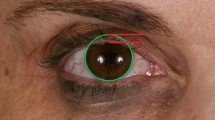Abstract
Black bone disease presents as abnormal osseous hyperpigmentation following tetracycline antibiotic use. Several case studies have reported this incidental finding in the setting of orthopedic, cranial, and oromaxillofacial surgery. Herein, we describe a case of black bone disease discovered intraoperatively in a 63-year-old female with a 3-year history of tetracycline use during adolescence for acne treatment. During routine endoscopic brow-lifting surgery, patchy dark frontal bone discoloration was observed through all four incision sites. The integrity of the bone appeared normal, and the operative procedure, including bone tunnel fixation, was completed without complication. Postoperative course was uneventful. We review previous reports of this finding, the proposed mechanisms by which tetracycline antibiotics induce bone discoloration, and discuss its surgical implications. This case is the first to our knowledge to describe the finding of black bone disease in the setting of facial plastic surgery.
Level of evidence: Level V, risk / prognostic study.


Similar content being viewed by others
Data availability
Not applicable.
Code availability
Not applicable.
References
Thiam D, Teo TY, Malhotra R et al (2016) Black bone disease in a healing fracture. BMJ Case Rep 2016:bcr2015211915. https://doi.org/10.1136/bcr-2015-211915
Chan CM, Hicks DG, Giordano BD (2012) Minocycline-induced bone discoloration: a case report. JBJS Case Connector 2(3):e47. https://doi.org/10.2106/jbjs.cc.k.00153
Smolar DE, Mureb MC, Fenstermaker RA (2020) Black bone disease of the skull. World Neurosurg 134:548. https://doi.org/10.1016/j.wneu.2019.11.114
Odell EW, Hodgson RP, Haskell R (1995) Oral presentation of minocycline-induced black bone disease. Oral Surg Oral Med Oral Pathol Oral Radiol Endod 79(4):459–461. https://doi.org/10.1016/s1079-2104(05)80128-3
Reed DN, Gregg FO, Corpe RS (2012) Minocycline-induced black bone disease encountered during total knee arthroplasty. Orthopedics 35(5):e737-739. https://doi.org/10.3928/01477447-20120426-30
Middleton SD, Anakwe RE, McKinley JC (2011) Black bone disease of the foot. Minocycline related pigmentation. Foot Ankle Surg 17(2):e34-36
Hoenig JF (1996) Rigid anchoring of the forehead to the frontal bone in endoscopic facelifting: a new technique. Aesthetic Plast Surg 20(3):213–215. https://doi.org/10.1007/s002669900023
Caprio RD, Lembo S, Costanzo LD et al (2015) Anti-inflammatory properties of low and high doxycycline doses: an in vitro study. Mediat Inflamm 2015:329418. https://doi.org/10.1155/2015/329418
Sapadin AN, Fleischmajer R (2006) Tetracyclines: nonantibiotic properties and their clinical implications. J Am Acad Dermatol 54(2):258–265. https://doi.org/10.1016/j.jaad.2005.10.004
Esterly NB, Koransky JS, Furey NL et al (1984) Neutrophil chemotaxis in patients with acne receiving oral tetracycline therapy. Arch Dermatol 120(10):1308–1313
Hilton HB (1962) Skeletal pigmentation due to tetracycline. J Clin Pathol 15(2):112–115. https://doi.org/10.1136/jcp.15.2.112
Cockings JM, Savage NW (1998) Minocycline and oral pigmentation. Aust Dent J 43(1):14–16. https://doi.org/10.1111/j.1834-7819.1998.tb00145.x
Kelly RG, Kanegis LA (1967) Metabolism and tissue distribution of radioisotopically labeled minocycline. Toxicol Appl Pharmacol 11(1):171–183. https://doi.org/10.1016/0041-008x(67)90036-1
Dahners L, Bos G (2002) Fluorescent tetracycline labeling as an aid to debridement of necrotic bone in the treatment of chronic osteomyelitis. J Orthop Trauma 16:345. https://doi.org/10.1097/00005131-200205000-00009
Harvey BR, Ephros H, DeFalco RJ (2004) Tetracycline bone labeling in surgical management of chronic osteomyelitis: a case report. J Oral Maxillofac Surg 62(6):752–754. https://doi.org/10.1016/j.joms.2003.08.036
Pautke C, Tischer T, Neff A, Horch HH, Kolk A (2006) In vivo tetracycline labeling of bone: an intraoperative aid in the surgical therapy of osteoradionecrosis of the mandible. Oral Surg Oral Med Oral Pathol Oral Radiol Endod 102(6):e10–e13. https://doi.org/10.1016/j.tripleo.2006.05.007
Pautke C, Bauer F, Bissinger O, Tischer T, Kreutzer K, Steiner T, Weitz J, Otto S, Wolff KD, Stürzenbaum SR, Kolk A (2010) Tetracycline bone fluorescence: a valuable marker for osteonecrosis characterization and therapy. J Oral Maxillofac Surg 68(1):125–129. https://doi.org/10.1016/j.joms.2009.05.442
Williams S, Wakisaka A, Zeng Q et al (1996) Minocycline prevents the decrease in bone mineral density and trabecular bone in ovariectomized aged rats. Bone 19(6):637–644. https://doi.org/10.1016/s8756-3282(96)00302-x
Sanchez AR, Rogers RS, Sheridan PJ (2004) Tetracycline and other tetracycline-derivative staining of the teeth and oral cavity. Int J Dermatol 43(10):709–715. https://doi.org/10.1111/j.1365-4632.2004.02108.x
Author information
Authors and Affiliations
Contributions
All authors contributed to the following case report. All authors read and approved the final manuscript.
Corresponding author
Ethics declarations
Ethics approval
All procedures performed in studies involving human participants were in accordance with the ethical standards of the institutional and/or national research committee and with the 1964 Helsinki Declaration and its later amendments or comparable ethical standards. For this case report, formal consent from a local ethics committee is not required.
Informed consent
Informed consent was obtained from the patient included in the study.
Patient consent
Patient signed informed consent regarding publishing her data and photographs. The participant has consented to the submission of the case report to the journal.
Conflict of interest
Nakra Tanuj is a shareholder of Global Beauty Science, Inc. Vaswani, Zameer G; Homer, Natalie A; and Epstein Aliza declare no competing interests.
Additional information
Publisher’s note
Springer Nature remains neutral with regard to jurisdictional claims in published maps and institutional affiliations.
Rights and permissions
About this article
Cite this article
Vaswani, Z.G., Homer, N.A., Epstein, A. et al. Black bone disease of the skull incidentally discovered during endoscopic brow lifting. Eur J Plast Surg 45, 183–186 (2022). https://doi.org/10.1007/s00238-021-01824-2
Received:
Accepted:
Published:
Issue Date:
DOI: https://doi.org/10.1007/s00238-021-01824-2




